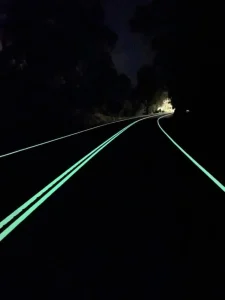Australians are lighting the way to safer roads at night with
a groundbreaking solution: glow-in-the-dark road markings.
Taking a cue from the luminous hands of tactical watches,
these innovative markings aim to enhance visibility
and improve road safety, particularly during nocturnal journeys.
Tarmac Linemarking / Facebook
This revolutionary initiative, spearheaded by Regional Roads Victoria as part of a comprehensive road safety program, will see selected roads in the state of Victoria adorned with photoluminescent paint. The glow-in-the-dark lines, a key component of the state’s Innovative Package, are poised to revolutionize nighttime driving experiences for motorists across the region.
Tarmac Linemarking / Facebook
While the concept has garnered praise for its potential to enhance road safety, some voices of concern have emerged, citing potential hazards associated with the newfound luminosity. Criticisms range from fears of increased temptation for drivers to switch off their headlights to apprehensions regarding the longevity and safety of the photoluminescent paint.
Nevertheless, proponents of the initiative remain undeterred, emphasizing the transformative impact it could have on road visibility and driver awareness. With an estimated cost of AUD $4 million (USD $2.82 million), the investment in glow-in-the-dark road markings underscores the commitment to pioneering solutions that prioritize public safety and well-being.
Tarmac Linemarking / Facebook
The implementation of glow-in-the-dark road markings is part of a multi-faceted approach to road safety, with additional measures aimed at enhancing visibility and guidance for motorists and pedestrians alike. Alongside the luminous road markings, the state’s ‘Innovation Package’ includes the use of road markings with heightened reflectivity, achieved through the incorporation of thicker glass beads and thermoplastic materials. This augmented reflectivity ensures improved visibility under the illumination of car headlights, further augmenting nighttime safety measures.
Tarmac Linemarking / Facebook
Furthermore, the introduction of LED tactile paving at controlled pedestrian crossings represents a pivotal step towards enhancing pedestrian safety, particularly in urban environments where distractions abound. By synchronizing the LED colors with traffic light signals, pedestrians are afforded heightened visibility and guidance, mitigating the risks associated with low visibility conditions.



